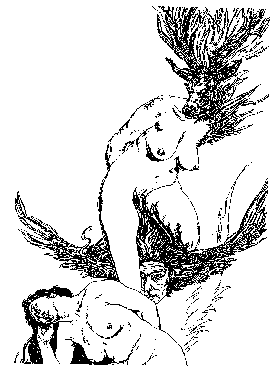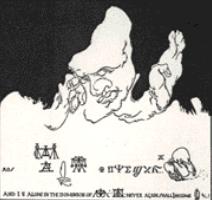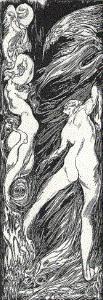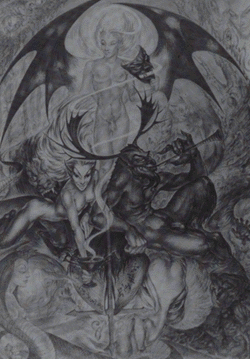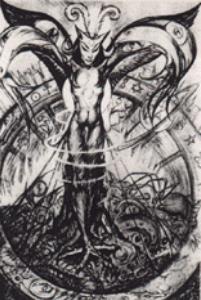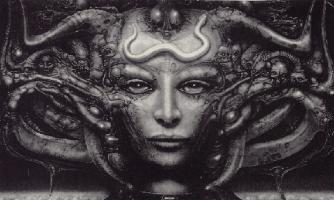 |
|
![]()
THREE MAGICAL ARTISTSAUSTIN SPARE, ROSALEEN NORTON & H. R. GIGERby Nevill Drury |
|||||||||||
|
If visionary art flows from the inspired and haunted depths of the psyche it comes as no surprise that certain artists have also been magicians. Their art becomes a type of evocation, a calling forth of the archetypal energies and presences that teem in the creative imagination. For these artists the revealed image provides a glimpse of more profound - and perhaps more menacing - realities that lie beyond the threshold of familiar consciousness. It is magical artists like these who remind us of the visionary potentialities which filter through the psyche like echoes from the Void. The three magical artist I would like to consider here are all creative eccentrics who have somehow managed to explore the elusive inner realms of the visionary imagination while still remaining nominally within the context of 20th century western culture. All three can be regarded, in a very characteristic sense, as artistic 'outsiders'. Only one - H. R. Giger - has attracted a degree of mainstream recognition, and he is also the only one of the three who is still alive: Austin Spare died a recluse in London in 1956 and Rosaleen Norton - the Witch of Kings Cross - departed this life in a Sydney hospice in 1979. So, what is it about these particular artists that demands our attention? I think the answer is that all three embody the concept of the artist as magician, and also the complementary role of the magician as artist. All of them show us through their art that the Universe is indeed a wondrous, mysterious, and at times terrifying place - and that consciousness exists on many levels. The magical artist is - by definition - a denizen of many parallel worlds.
|
|||||||||||
Inspired by the classical gods of ancient Egypt and also by his personal link with an elderly witch named Mrs Paterson and an inner-plane entity called Black Eagle, Spare moved rapidly from conventional figurative art to an inspirational style of magical surrealism. Spare's career had begun in an impressive but orthodox way when he won a scholarship to the Royal College of Art at the age of sixteen. Admired by Augustus John, George Bernard Shaw and John Sargent, he was considered an artistic prodigy and was later commissioned to illustrate a handful of books, including Ethel Wheeler's Behind the Veil (1906) and a book of aphorisms titled The Starlit Mire (1911). In the early 1920s he was co-editor with Clifford Bax of an excellent illustrated literary journal called The Golden Hind which ran for eight quarterly issues (1922-24) and featured articles by such luminaries as Aldous Huxley, Alex Waugh and Havelock Ellis. Spare's drawings for the journal were mostly of sumptuous, naked women and there was only a hint of the magical world which had already begun to profoundly inspire him. If Spare had continued to move in conventional literary circles he may, perhaps, have become better known as an artist - at least as well known, for example, as the noted illustrator Edmund J. Sullivan who provided images for The Rubaiyat of Omar Khayyam and whose graphic style was in many ways comparable to Spare's early work. But Spare had already decided that he would self-publish his writings and drawings dealing with the exploration of magical consciousness. Indeed, his esoteric inclinations were already leading him away from the cultural mainstream. Spare's cosmology is complex but instructive. He believed in reincarnation and claimed that all his former lives, whether as a human or animal, were deeply embedded in the subconscious mind. The mystical purpose of man was to retrace those existences back to their source, and this could be done in a state of trance - whereby one allowed oneself to be possessed by the 'atavisms' of former lives. Spare termed the primal and universal source of Being 'Kia', and he referred to the human body as 'Zos'. For Spare, the latter was the ideal vehicle through which to manifest the spiritual and occult energies of the otherwise hidden universe. He regarded this level of the mind as 'an epitome of all experience and wisdom, past incarnations as men, animals, birds, vegetable life... everything that exists, has or ever will exist'. His actual technique of arousing these primal images - the technique he named 'atavistic resurgence' - involved focusing his will on magical sigils, which he developed to represent 'instruction like 'This is my wish; to obtain the strength of a tiger' into a single graphic anagram composed of the letters in the sentence. Having established his core sigil, Spare would then close his eyes and focus both on the sigil and the associated wish-intent that accompanied it. According to Spare's friend and fellow occultist, Kenneth Grant, the effect was dramatic:
Spare had visited Egypt during World War I and was impressed by the magnetic presence of the classical deities depicted in monumental sculpture. He considered the ancient Egyptians to have been a nation of people who understood very thoroughly the complex mythology of the subconscious mind:
For Spare, impressions from earlier incarnations and all mythic impulses could be reawakened from the subconscious mind: 'All Gods have lived (being ourselves) on earth,' he wrote, 'and when dead, their experience or Karma governs our actions in degree.' The artist learned his technique of atavistic resurgence from Mrs Paterson, who claimed a psychic link with the witches of the Salem cult. He also began to produce automatic drawings in the trance state through the mediumship of an entity he called Black Eagle, and who took the form of an American Indian. Spare claimed to see him several times and, in general, lived in a perceptual universe where the everyday world and the images of trance and hallucination seemed to intermingle. On one occasion, while riding in a double-decker bus, Spare found himself surrounded by a group of 'imaginary' passengers - an assembly of witches bound for the Sabbath! Spare's attraction to the ageing Mrs Paterson was quite understandable when we consider the magical context of their relationship. According to Spare she was able to transform herself perceptually from being a 'wizened old crone' to appearing quite suddenly as a 'ravishing siren'. For Spare, the idea of a woman with no apparent fixed or finite form had great appeal - and the Universal Goddess was, after all, a central aspect of his magical cosmology. Spare was adamant that the Goddess could not be culturally or mythically contained: '...nor is she to be limited as any particular goddess such as Astarte, Isis, Cybele, Kali, Nuit - for to limit her is to turn away from the path and to idealize a concept which, as such, is false because incomplete, unreal because temporal.'
Several of Spare's drawings depict the Divine Maiden leading the artist into the labyrinthine magical world. One of his most important single works, The Ascension of the Ego from Ecstasy to Ecstasy - which is included in his self-published masterpiece of 1913, The Book of Pleasure - shows the Goddess welcoming Spare himself, who on this occasion appropriately has wings issuing forth from his head. Spare's 'ego', or personal identity, is shown merging with an earlier animal incarnation and the two forms transcend each other in the form of a primal skull - union with Kia. And in another fine work, Now for Reality, the Maiden is there once again, lifting a veil which leads to the mysterious realm beyond. In the foreground are all manner of creatures - an owl, a field mouse, a horned devil - but clearly reality lies 'beyond' - in the nether regions revealed by the Goddess. Undoubtedly one of Spare's major magical objectives in using the trance state was to tap energies which he believed were the source of genius. As Spare himself commented, '... ecstasy, inspiration, intuition and dream ... each state taps the latent memories and presents them in the imagery of their respective languages'. Genius, according to Austin Spare, was a 'directly resurgent atavism' experienced during the ecstasy of the Fire Snake or Kundalini...'.
Her father was a captain in the merchant navy and a cousin of musical composer Vaughan Williams. The Norton family emigrated to Sydney in 1925. While her parents had orthodox religious beliefs, young Rosaleen made contact with the magical world very early indeed. At the age of three she was already drawing animal-headed ghosts and when only five observed an apparition of a shining dragon beside her bed. Later in secondary school in Sydney she illustrated Saint Saens' Dance Macabre - complete with vampires, ghouls and werewolves. Her pagan orientation was noted by the teaching staff and in due course she was expelled from the school under a cloud - her headmistress commenting that she had a 'depraved nature which would corrupt the innocence of the other girls'. During her teen years, after working briefly as a writer for Smith's Weekly, Rosaleen studied art with the famous sculptor Rayner Hoff, became one of Australia's first women pavement artists and then drifted from one job to another - designing for a toy manufacturer, assisting in night-clubs, and doing stints of waitressing and modelling. But at this time she also began to research psychology, magic and metaphysics - studying in depth the writings of Carl Jung, William James and occultists like Eliphas Levi, Madam Blavatsky, Dion Fortune and Aleister Crowley. She also discovered techniques that could heighten her artistic perception: through self-hypnosis, for example, she learned how to transfer her attention at will to inner planes of awareness. These experiments, she later wrote, 'produced a number of peculiar and unexpected results... and culminated in a period of extra-sensory perception together with a prolonged series of symbolic visions'. The following extracts come from a transcript of an interview between Rosaleen Norton and a psychologist, L. J. Murphy, conducted at the University of Melbourne in 1949. They provide a fascinating insight into her visionary exploration of trance states:
Rosaleen came to have a special reverence for the Great God Pan and regarded him as the Totality of All Being - the true God of the World and Overlord of the Balance of Nature. There were other major deities too - Lucifer, Baphomet, Hecate and Jupiter - but according to Rosaleen they would only appear to her in her trance visions if it pleased them - it was not a case of the magician summoning the gods to answer every beck and call! And there were lesser forces in Rosaleen's occult hierarchy as well, including a number of demons, spirit beings and astral forms. Some of the magical entities that appear in her artistic works seem to be atavistic hybrids - half-human, half-animal and often naked - revealing the primeval aspects of humanity's spiritual evolution. Somewhere like Austin Spare, Rosaleen Norton came to regard her art as a means of depicting an alternative, and potentially much more impressive reality than the world of familiar appearances. In an early entry in her magical journal she wrote
Much of Rosaleen Norton's art was influenced by the Vorticist and Cubist schools of modernism but her visionary imagery retains a strength which is uniquely its own. The images were first published in 1952 in a controversial volume entitled The Art of Rosaleen Norton, co-authored with poet Gavin Greenlees. While Rosaleen's drawings do not seem especially confrontational now, they must have in the 1950's because the book's publisher, Wally Glover, was summoned before a magistrate and fined for publishing a work which contained illustrations 'offensive to public chastity and human decency'. Looking back on this situation now, it seems clear that Rosaleen's admittedly pagan drawings touched a nerve which challenged narrow Judaeo-Christian sensibilities. Her best work certainly has an archetypal power of its own.
Like Austin Spare, Rosaleen Norton was adept at exploring the states of trance consciousness in which she would have her visionary encounters with the gods. When she died in 1979 she had already become a legendary figure - but for all the wrong reasons. In her day - plagued by charges of obscenity and also accused by the tabloid press of holding Black Masses in her Kings Cross coven - Rosaleen Norton was considered a pagan deviant, and her artworks were judged to be bizarre and pornographic. Today we can re-evaluate her work in a new light. Her images seem now to cross a type of frontier, giving form to archetypal and visionary realities which for most people do not intrude into consciousness. Perhaps in the 1950's this is what made her work seem so shocking - that she dared to bring to light images from that deep layer of the psyche which for most people remains forgotten or repressed.
H. R. GIGERBest known as the creator of The Alien for the movie of the same name, Hans-Ruedi Giger was born in Chur, Switzerland, in 1940. Unlike Austin Spare and Rosaleen Norton, Giger did not initially develop his unique form of visionary art within a consciously acknowledged esoteric tradition. Rather, the art-forms evoked from his psyche drew him increasingly towards the magical realm. Giger's images often take shape in ethereal misty-grey light, leading the viewer into nightmarish caverns or into magical spaces from which there is no tangible means of escape. In recent years Giger has become very much an intuitive magician - his art providing a haunting testimony to the potent energies which stir deep down within the wellspring of the psyche. As a child Giger built skeletons of cardboard, wire and plaster and had an 'overwhelming disgust of worms and snakes' - a loathing which still manifests itself in his paintings today. Also, while training at the Zurich School of Applied Arts, he became fascinated by images of torture and horror - a fascination stimulated by being shown photographs of the hideous murder of the Emperor of China in 1904, and also by learning of the legends associated with Vlad the Impaler - the historical figure on which the Dracula tales were founded. Giger later became intrigued by the fantasy writings of H. P. Lovecraft, especially his Cthulhu mythos and Necronomicon. Part of the appeal, as he has himself acknowledged, was that the Necronomicon purported to be ...'a book of magic which would bring dreadful misfortune to mankind should it fall into the wrong hands. It includes the legend of the great gods with almost unpronounceable names, such as Cthulhu and Yog-Sothoth, who slumber in the depths of the earth and oceans and who will arise at a certain time - when the stars are right - to seize world domination'. Giger's friend and mentor Sergius Golowin later suggested Giger's Necronomicon as a title for the first major book on the artist's visionary art-works - a remarkable collection of esoteric images first published in Basle in 1977 and later released in an English edition. Many of Giger's most distinctive paintings are based substantially on the beautiful actress, Li Tobler, whom Giger met in 1966 - when she was 18 years old and living with another man. Giger moved into her attic apartment and in due course they became lovers. Giver recalls that Li 'had enormous vitality and a great appetite for life'. She also wanted her life to be 'short but intense'. Li Tobler is the prototype for the many tortured but ethereal women in Giger's paintings who peer forth from the torment of snakes, needles and stifling prison-vaults fashioned from bones. Giger painted Li's body several times with an airbrush and there are a number of photographs of her posing naked - like a woman of mystery struggling to emerge from a nightmare that has possessed her soul. Regrettably, the life of Li Tobler came to a sudden and tragic end. Drawn increasingly into an intense schedule of theatrical performances around the country and also plunged into emotional turmoil following a succession of other lovers, Li shot herself with a revolver on Whit Monday 1975. When I met Giger in his Zurich home in 1984, to film a sequence for the television documentary The Occult Experience, it was clear that he was still haunted by Li Tobler: the simultaneous agony and job of living with her had helped establish a dynamic of fear and transcendence in the paintings, and this was an ongoing legacy of their relationship. Giger now lives in an atmosphere that simultaneously evokes a sense of magic and paranoia. The main downstairs room in his two-storey terrace house is dominated by remarkable paintings which feature Medusa-like women with ghostly-pale skin, snakes in their hair and strange shapes and forms writhing around their bodies. Claws, needles, machine-guns and barbs have also become a central aspect of Giger's visual iconography. In the centre of the long table which occupies his living room is an engraved pentagram, and also a set of candlesticks whose flames cast an eerie light on the paintings nearby. A tall row of shelves in one corner of the room reveals a row of skulls and authenticshrunken heads from a cannibalistic tribe. It is here that Giger has placed his Oscar, won for special effects in Alien - a tribute to his bizarre imagination. Upstairs, Giger has his studio. At one end it is total chaos - a litter of splattered paint, brushes and discarded works of art. Here he experiments with his airbrush techniques, spraying patterns through metal grids and exploring different textures of light and shade. At the other end of the long, open room, is a large black table with bulbous legs and an extraordinary mirror sheen on its pristine surface. Fashioned substantially from heavy moulded plastic, it is accompanied by several tall chairs surmounted with skulls and shaped to give the impression of distorted vertebrae. An ash-grey version of these chairs - seemingly formed from bone itself - has pride of place at the head of the table. And gracing the long wall above is another large panel - this time depicting a horned devil, a silver pentagram and dark, hostile serpents. I asked Giger about his occult affiliations and he confirmed that although he has studied the works of Aleister Crowley, he does not perform rituals, engage in invocations or summon spirits. Nevertheless one could hardly find a better temple of the black arts than Giger's main living room, and the astral beings which inhabit his paintings are themselves like a pantheon of demons. It would seem, then, that Giger makes magic spontaneously. 'I try to come close to my imagination', he says in his broken English. 'I have something in my head and I try to work it out - like a kind of exorcism'. When the thin veil across Giger's psyche is drawn aside just a little, remarkable and tempestuous visions come forth. It is as if the dark gods are emerging once again from the nightmares of his past. IN CONCLUSION As I noted earlier there are distinctive parallels between Austin Spare and Rosaleen Norton. Both were influenced by witchcraft and the occult traditions of western magic, both utilised trance states, and both believed that the realm of the gods had its own intrinsic existence - the artist simply serving to manifest these archetypal energies by acting as an inspired channel. It is also interesting that both employed mental focusing techniques - using sigils or specific physical objects to induce a state of trance. As in the Eastern forms of meditation which utilise 'one-centredness of mind', it seems that the focusing of intent is a valuable way of unleashing stored psychic energy. H. R. Giger, on the other hand, provides us with a somewhat different orientation. His art does not derive from trance states per se, but flows, nevertheless, from a type of exorcism of the soul. In a foreword to a recent collection of Giger's works published in 1991, Timothy Leary confirms the impact of Giger's evocative art: 'Giger, you razor-shave sections of my brain and plaster them, still pulsing, across your canvas ... Like it or not, we are all insectoid aliens burrowing within our urbanoid bodies. Giger's fleshscapes, his microscopic slides, are signals to mutate.' This
is an extract from ECHOES FROM THE VOID: Writings on Magic, Visionary
Art and the New Consciousness, which was published by Prism/Unity
early in 94. Used in Shadowplay with the author's permission.
|
|||||||||||
